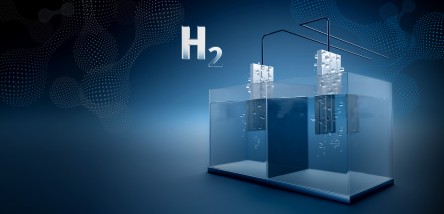Why do we need safe hydrogen?
Hydrogen is highly reactive and extremely flammable. In addition, high temperatures, pressure and electrical voltage interact in production processes. Functional safety is not an optional extra, but a mustfor safe and reliable operation.

Electrolysis: the central step in hydrogen production
In an electrolyser, water is separated into hydrogen and oxygen using electricity. Both gases must be safely separated and routed. Automated processes help to increase safety and optimise workflows at an early stage. This helps to avoid any risks.
What are the specific risks?
During electrolysis explosive gas mixtures are produced. Leakages, incorrect valve design or defective sensors can be hazardous. That is why safety-relevant components – such as pressure vessels and measuring systems – have to function reliably.

How mandatory SIL standards help
IEC 61508 by the International Electrotechnical Commission (IEC) specifies howcompanies must develop and operate safety-critical systems worldwide. It applies across all industries and forms the basis for many other safety standards.
The IEC has basedIEC 61511 for the process industry on this standard. This standard is aimed at system operators in sectors such as chemicals, oil & gas or pharmaceuticals and describes the practical implementation of functional safety.
Both standards use SIL levels (Safety Integrity Level 1–4) to determine the required level of risk reduction. This allows each hazard to be assessed so that suitable protective measures can be taken.
Why is SIL so important for hydrogen production?
It would be hard to imagine safe hydrogen without SIL. SIL-compliant systems detect errors automatically, react reliably and bring systems to a safe state. This not only protects people, but also machines and the environment.
How do you fulfil the SIL requirements?
It is not enough to just make sure individual components are safe. For safe operation, all parts of a control loop – sensors, controllers and actuator technology – must interact optimally and possible risks must be assessed. This can be achieved through advice, planning and finding suitable products for your system. A common misconception is that implementation is expensive. In actual fact, functional safety saves money by lowering the failure rate, reducing the need for maintenance and extending service life.
Safely using hydrogen thanks to automation
By having the right partner, safety is easy to plan. Festo supplies tried-and-tested automation technology, from smart sensors and modular controllers to complete control cabinets. Everything is geared towards the safe production of hydrogen. We have many years of experience in relevant industries, such as the chemical industry, and support you from the initial idea through to commissioning.
Your checklist for safe hydrogen production
☑ Know the risks involved in hydrogen production
☑ Apply SIL 61508 as a mandatory safety standard
☑ Analyse risks and provide appropriate safeguards
☑ Choose experienced partners with industry expertise and knowledge of standards
☑ Use automation with tried-and-tested components and systems
☑ Produce hydrogen safely and efficiently with Festo